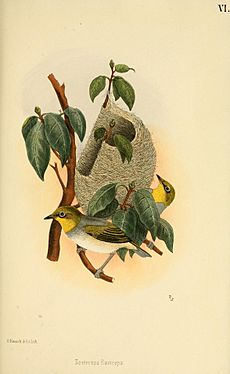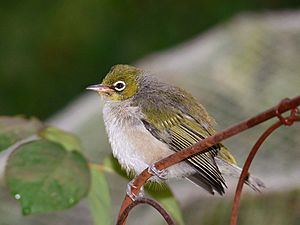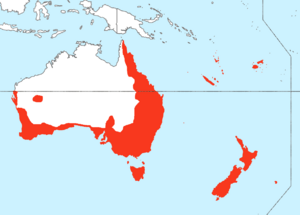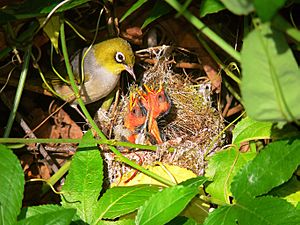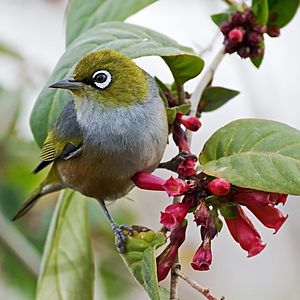Silvereye facts for kids
Quick facts for kids Silvereye |
|
|---|---|
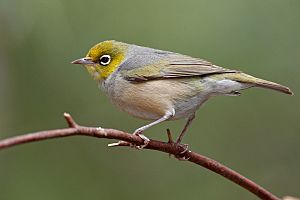 |
|
| Conservation status | |
| Scientific classification | |
| Genus: |
Zosterops
|
| Species: |
lateralis
|
The silvereye is a small bird found in the south-west Pacific. It's also known as the wax-eye. This bird eats both plants and insects.
In Australia and New Zealand, people sometimes call it the white-eye. However, "white-eye" usually refers to a whole group of similar birds.
The silvereye was first seen in New Zealand in 1832. Many more arrived in 1856. It's thought that a storm blew a group of migrating birds off course. Because it arrived on its own, it's protected as a native New Zealand species. Its Māori name, tauhou, means "stranger" or "new arrival."
Contents
About the Silvereye's Name
The English bird expert John Latham first described the silvereye in 1801. He gave it the scientific name Sylvia lateralis.
There are 17 different types, or subspecies, of the silvereye:
- Z. l. chlorocephalus (Capricorn silvereye) – Found in central Queensland, Australia.
- Z. l. chloronotus (western silvereye) – Lives in south-west Western Australia and parts of South Australia.
- Z. l. cornwalli – Found in east-central and south-east Queensland to north-east New South Wales.
- Z. l. flaviceps – Lives in Fiji.
- Z. l. griseonota – Found in New Caledonia.
- Z. l. lateralis – Lives on Flinders Island, Tasmania, Norfolk Island, New Zealand, and Chatham Islands. It also migrates to south-eastern Australia.
- Z. l. macmillani – Found on Tanna and Aniwa Islands in southern Vanuatu.
- Z. l. melanops – Lives on Lifou, Loyalty Islands, New Caledonia.
- Z. l. nigrescens – Found in the Loyalty Islands, New Caledonia.
- Z. l. ochrochrous – Lives on King Island, Tasmania.
- Z. l. pinarochrous – Found in south-east South Australia, south-west New South Wales, and western Victoria.
- Z. l. tephropleurus (Lord Howe silvereye) – Lives on Lord Howe Island.
- Z. l. tropicus – Found in the Torres Islands and Banks Islands, and on Malo and Espíritu Santo in north-west Vanuatu.
- Z. l. valuensis – Lives on Mota Lava, Banks Islands, Vanuatu.
- Z. l. vatensis – Found in central and southern Vanuatu.
- Z. l. vegetus – Lives in north-east Queensland.
- Z. l. westernensis – Found in south-east New South Wales to eastern Victoria.
What Does a Silvereye Look Like?
The silvereye is a small bird, about 11 to 13 centimeters (4 to 5 inches) long. It weighs around 10 grams (0.35 ounces). It has a clear ring of white feathers around its eye, which is how it got its name!
Its feathers can look a bit different depending on the subspecies. Generally, silvereyes have:
- Olive-green wings.
- A back that is either grey or olive-green.
- A lighter throat, which can be yellow or grey.
- Sides (flanks) that are chestnut or pale buff.
- An undertail that might be white or yellow.
In Australia, silvereyes move around with the seasons, so different types can be seen in the same areas. On other islands, usually only one type of silvereye lives there, so they all look similar.
Where Do Silvereyes Live?
Silvereyes are native to Australia, New Zealand, and islands in the south-west Pacific. These islands include Lord Howe, New Caledonia, the Loyalty Islands, Vanuatu, and Fiji.
They are very common in the fertile south-west and south-east parts of Australia. This includes Tasmania and the islands in the Bass Strait. They also live along the well-watered coast of tropical Queensland, including Cape York Peninsula.
You can find silvereyes in almost any area with plants. They live in forests, scrublands, orchards, and even city gardens. They usually avoid open grasslands.
What Do Silvereyes Eat?
Silvereyes eat insects, lots of fruit, and nectar from flowers. Because they love fruit, they can sometimes be a problem for fruit farms.
Silvereye Behavior and Life Cycle
Silvereyes build their nests in spring and early summer, mainly from September to December. They make a tiny cup-shaped nest from grass, moss, hair, spiderwebs, and thistledown. They hang these nests from branches in small trees or bushes.
They lay two to four pale blue eggs. A pair of silvereyes might raise two or even three groups of chicks during one breeding season. The eggs hatch after about 11 days. The young birds leave the nest after another 10 days. Young silvereyes can live on their own at 3 weeks old and can start having their own babies at 9 months old.
In late summer, silvereyes gather into large groups. Many Australian birds migrate, flying north along the coast. They spend their days looking for food, calling to each other, and moving quickly through bushes. Then, they fly long distances through the night.
Most silvereyes from Tasmania fly across the Bass Strait. This is amazing for such small birds! They spread out into Victoria, New South Wales, and south-eastern Queensland. Birds from these areas tend to fly even further north. However, the silvereyes living in the far north stay in one place all year. In Western Australia, they have been seen moving between the mainland and islands offshore.
Silvereyes eat many different things. Their diet includes insects, berries, fruit, and nectar. In New Zealand, they eat fruit from native trees like kahikatea and rimu. If food is hard to find in winter, they will eat a wide range of foods from bird tables. This can include sugar water, bread, cooked meats, and even solid pieces of fat.
Silvereyes and People
In Gardens and Farms
Silvereyes are helpful in gardens and orchards because they eat insects that can harm plants. These insects include aphids, scale insects, and the diamondback moth.
However, some fruit growers and home gardeners see them as a problem. Because they are so small, they can easily get through bird nets. They are attracted to many types of fruit, such as apples, citrus, feijoas, figs, grapes, pears, and persimmons.
In Books
A silvereye is the main character, Honey, in a series of children's books. These books are Honey and Bear, Special Days with Honey and Bear, and The Honey and Bear Stories. They were written by Ursula Dubosarsky and illustrated by Ron Brooks.
In his 2010 book Drawn from the Heart, Ron Brooks shared how he got the idea for Honey. He saw a silvereye in his garden in Tasmania. He said, "those large silver rings with a fine black line around the outer edge, right round the eyes ... She's perfect, I thought. That's her! That's Honey."
See also
 In Spanish: Anteojitos dorsigrís para niños
In Spanish: Anteojitos dorsigrís para niños



